So much comes to mind when I think about the Eternal City and archaeological sites in Rome is one of the first and most important ones as with any cultural travel.
 Has it ever happened to you that you visit a place for the first time and you fall completely in love with it?
Has it ever happened to you that you visit a place for the first time and you fall completely in love with it?
That was exactly my experience in Rome. Art, architecture, history, archaeology, anthropology, culture, beauty… they all describe Rome and they are the best in cultural travel.
It is truly one of the most beautiful cities in the World and you can find all aspects of culture there.
The most spectacular archaeological sites in Rome
So when I asked myself about the Top 10 archaeological sites in Rome, it was kind of a hard choice!
From magnificent massive structures like the enormous Baths of Caracalla, to the more obscure small sites like Largo Argentina, it is all awe inspiring.
Many didn’t make the cut, but I’ll be sure to leave them for future posts. They are all extremely interesting!
Please beware that we can speak volumes of each of these sites but the idea with this post is for you to get a sense of the vast history of Rome.
So without further ado, here’s my list!
10: Ara Pacis
Emperor: Augustus.
Time period: 13 BC to 9 BC. (Yes, Christ hadn’t even been born!)
The Ara Pacis is a monument in Rome dedicated to the Pax Augusta, the Augustan Peace during the reign of Roman Emperor Augustus.
Augustus was the first true Emperor after the Republic and he had a very successful time in power.
The Ara Pacis was commissioned by the Senate to honor the Emperor after his triumfal military campaigns in Hispania and Gaul.
The monument is completely made of marble and it consists basically of an altar surrounded by an enclosure with one main entrance and another opening at the back.
The inside walls are filled with symbolism related to abundance and prosperity while the outer walls depict members of Augustus’ family.
The use of family members and statues of past relatives is meant to make clear that Augustus lineage comes from the very foundation of Rome, via Romulus from Aeneas, through Julius Caesar.
The Ara Pacis has been reconstructed and today it’s housed inside the Museo dell’Ara Pacis, a fantastic modern structure designed by architect Richard Meier in 2006.
The visit comprises a look at the genealogical tree of Augusts’ family, busts of famous family members and an incredible modern design gift shop.
Also, information about Augusts’ plan for this site, which is next to his own Mausoleum and included a sun dial.
Resources:
Ara Pacis offiicial website.
Amazing virtual tour of the museum of the Ara Pacis.
The Ara Pacis – Myth at the Heart of the Roman Empire
9: Domus Aurea
Emperor: Nero.
Time period: 64 – 68 AD. (Christ had been dead for more than 30 years).
Domus Aurea means “Golden House” and it was a villa commissioned by mad Emperor Nero for him to live in, after the famous great fire in 64 AD (which he was accused of).
It is located at the heart of Rome and held an impressive palace and gardens, an artificial lake and most importantly the colossal statue of the Emperor (Forever lost).
After the death of Nero the palace was dismantled and the artificial lake dried out.
Years later Emperor Vespasian built the Flavian Amphitheatre (The Colosseum) on top of it, giving this portion of land back to the people.
The Baths of Titus, the Baths of Trajan,[1] and the Temple of Venus and Rome were also built on the site.
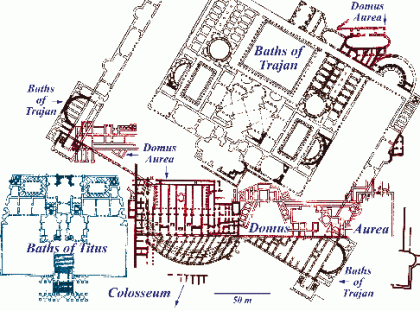
Domus Aurea plan, with Baths of Titus and Trajan.
Photo: www.athenapub.com
A small part of the palace still remains under the ruins of the Baths of Trajan and it is a testimony to the skilled labor that Nero hired with its lavish decoration and exuberant style.
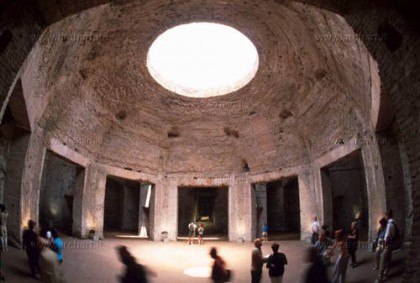
Octagonal room, an architectural innovation.
Photo: wcsa2012.webs.com
Many innovations in art and architecture were introduced with the design of the Domus Aurea by architects Severus and Celer and the painter Fabullus (isn’t that a fabulous name?).
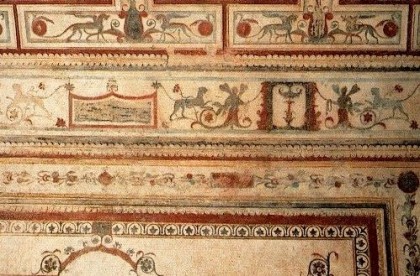
Domus Aurea, frescoes. Photo: Wikipedia.
Please copy and paste the following link to go to the original image:
http://www.culturaltravelguide.com/wp-content/uploads/2012/06/sites-in-rome-domus-aurea-01.jpg
Unfortunately, the site has been closed for a couple of years for restoration and I heard that it floods sometimes, making the work difficult. It’s not known when it will open again.
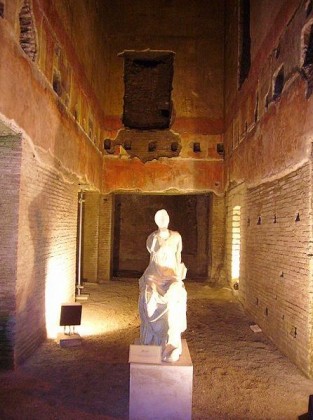
Photo: Howard Hudson (Feb 2007)
Please copy and paste the following link to go to the original image:
http://en.wikipedia.org/wiki/File:Statue_Domus_Aurea.jpg
According to writer Suetonius, when the palace was finished Nero remarked: “Good, now I can at last begin to live like a human being!”
Resources:
Domus Aurea website.
8: Vatican Necropolis
Emperor and time period: From the 1st to the 3rd century, starting with Augustus.
The Vatican Necropolis is basically a first century cemetery where Apostle Peter is said to have been buried some time around 60 AD, after the death of Jesus.
Is it the actual site of Saint Peter’s Basilica, the immense church in the Vatican, where the head of the Catholic Church and the Vatican State reside.
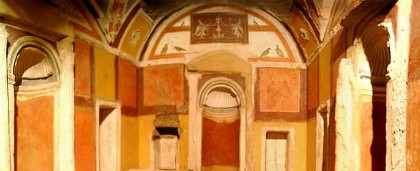
Interior of Mausoleum I. Photo: www.vatican.va
The visit to the actual archaeological site is amazing, with mausoleums of wealthy ancient Romans and a fascinating tale of how the tomb of Saint Peter came to be.
And as archaeological evidence and tradition suggest, it is the actual tomb of Saint Peter and his bones can be seen there.
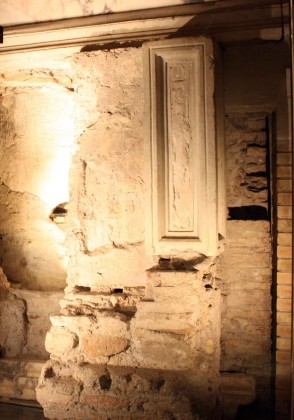
St Peter’s bones center left in glass container. Photo: Blanca & Ian’s Travels, members.rennlist.com/imcarthur/roma.htm
Quite a humbling experience to be able to experience what death must have been like for people in the Roman Empire.
I’ve written about the Vatican Necropolis in quite a lot of detail.
If you’re planning on visiting Rome, the Vatican Necropolis is a must-see! You need to make reservations at least four months in advance, by emailing the Scavi Office scavi@fsp.va
Resources:
Visit the FAQ page of the Scavi.
Amazing Virtual 360° tour of the Vatican Necropolis
7. Castel Sant’Angelo
Emperor: Hadrian.
Time period: 135 – 139 AD.
The Mausoleum of Hadrian, aka Castel Sant’Angelo is a round structure commissioned by Roman Emperor Hadrian as his and his family’s final resting place.
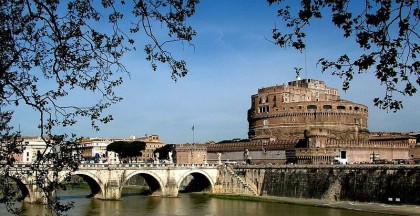
Photo: Kiss Tamás, Wikipedia.
Please copy and paste the following link to go to the original image:
http://upload.wikimedia.org/wikipedia/commons/thumb/3/3f/Angyalvar036.jpg/800px-Angyalvar036.jpg
It is located near the Vatican and I believe there are underground passages that link it to the Papal buildings.
Because of this it has been used as a fortress to protect popes.
It’s called Castle of the Holy Angel because it is believed that Archangel Michael appeared on top of it in 590.
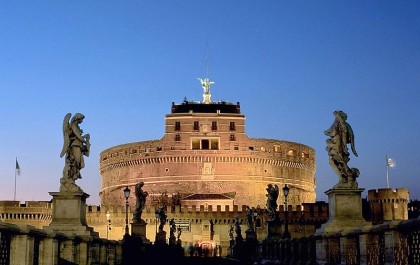
Photo: Andreas Tille, Wikipedia.
Please copy and paste the following link to go to the original image:
http://upload.wikimedia.org/wikipedia/commons/thumb/9/90/RomaCastelSantAngelo-2.jpg/800px-RomaCastelSantAngelo-2.jpg
In antiquity the building had gardens on top of it and a quadriga statue of the Emperor. After Hadrian, the mausoleum was used by several subsequent emperors, the last one being Caracalla in 217 AD.
Resources:
Oficial Castel Sant’Angelo website.
6: Temples in the Forum Boarium
Emperor: None, these temples come from the time of the Roman Republic, before the Roman Empire.
Time Period: 2nd century BC until around 80 BC. (No Christ yet).
The Forum Boarium is a piece of land located near the Tiber between the Capitoline, the Palatine and Aventine hills.
It is particularly important today because two of Rome’s oldest temples are still there in quite a magnificent condition.
The Temple of Hercules Victor is a round temple that dates from the 2nd century BC. It’s called sometimes the Temple of Vesta because of its similar shape to that one of the Roman Forum.
But that is a wrong assumption. The interior wall of the cella and 19 columns are original, and this temple is the oldest surviving building in all of Rome.
The Temple of Portunus is a rectangular temple with elements of an Etruscan plan. It was built between 100 and 80 BC.
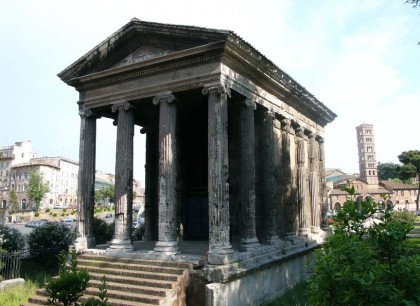
Photo: heater09.files.wordpress.com
Both temples owe their state of conservation to the fact that they’ve been used as churches before.
To think that to stand before these two buildings and think that they’ve been there since before there was a Roman Empire is simply… mind-boggling and astonishing.
Visiting the Forum Boarium is free!
Resources:
Ok, so meet me here next time to find out about the next five archaeological sites in Rome you can’t miss!
Was any of these sites in Rome a surprise?
Had you heard about them?
Share your comments in the field below!
And join the conversation in Facebook!



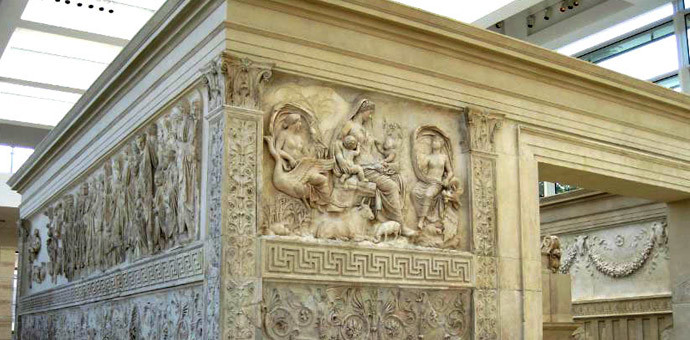
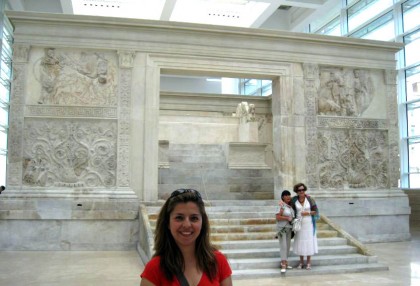
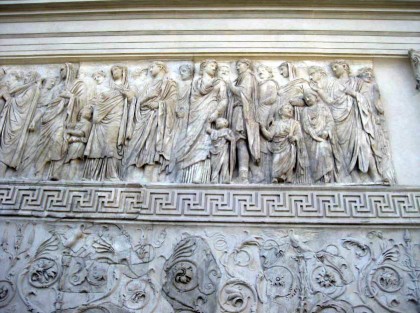
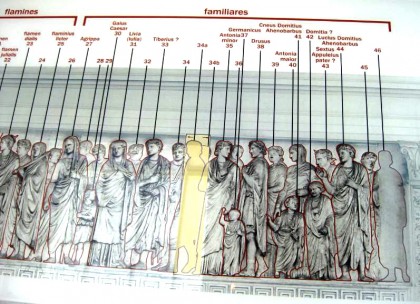
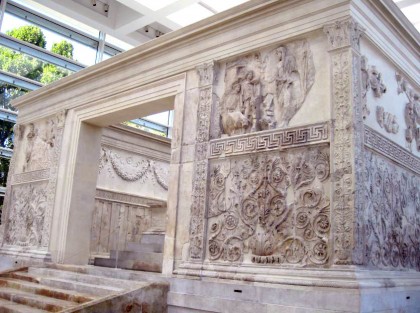
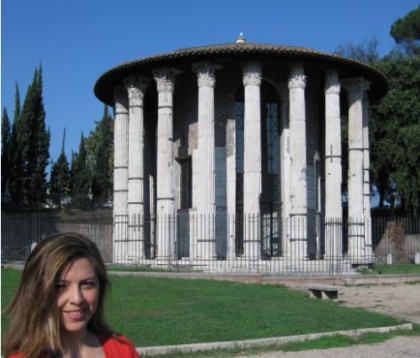
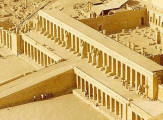

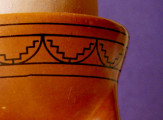
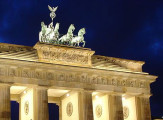
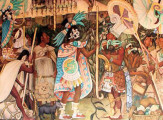
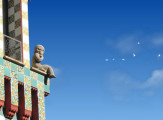
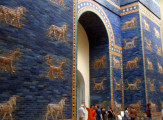
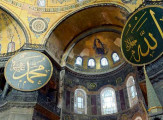
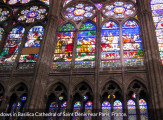
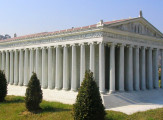


















Thank you for all of the links. Magnificent!
You’re very welcome, Suzanne!
Carolina, thanks for sharing these great parts of history in Rome! Having visited Rome twice I have been to most of the bigger monuments (Colosseum, Vatican etc), but now I am aware of these other options for next time I have a chance to visit!
Fantastic! Definitely Rome has got to be my persona favorite… There’s a piece of history waiting for you in every corner…